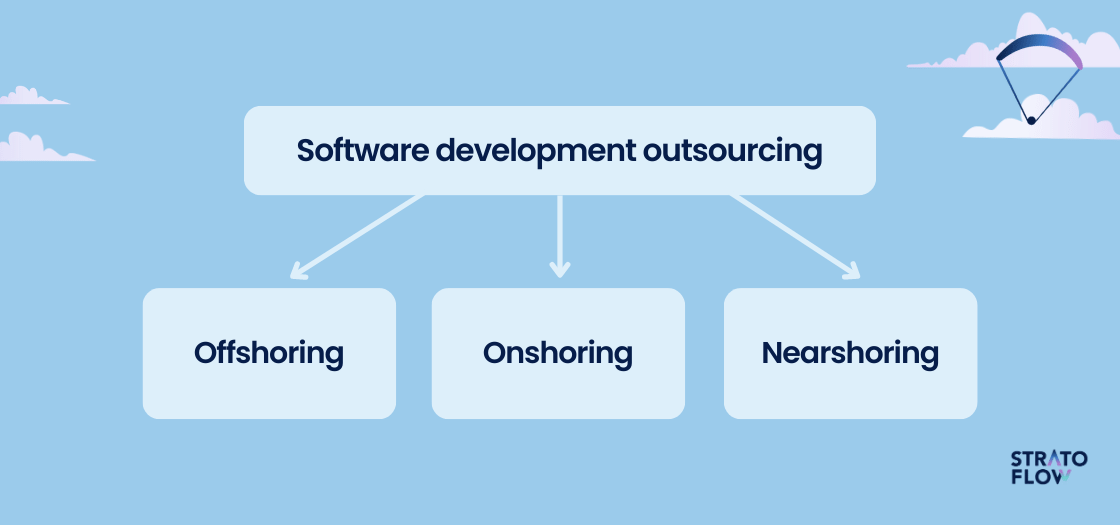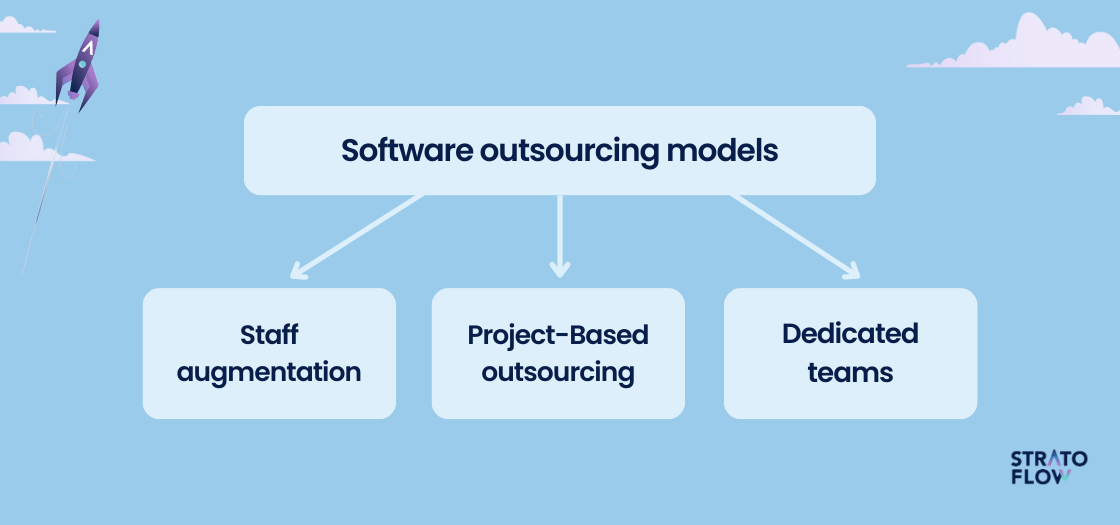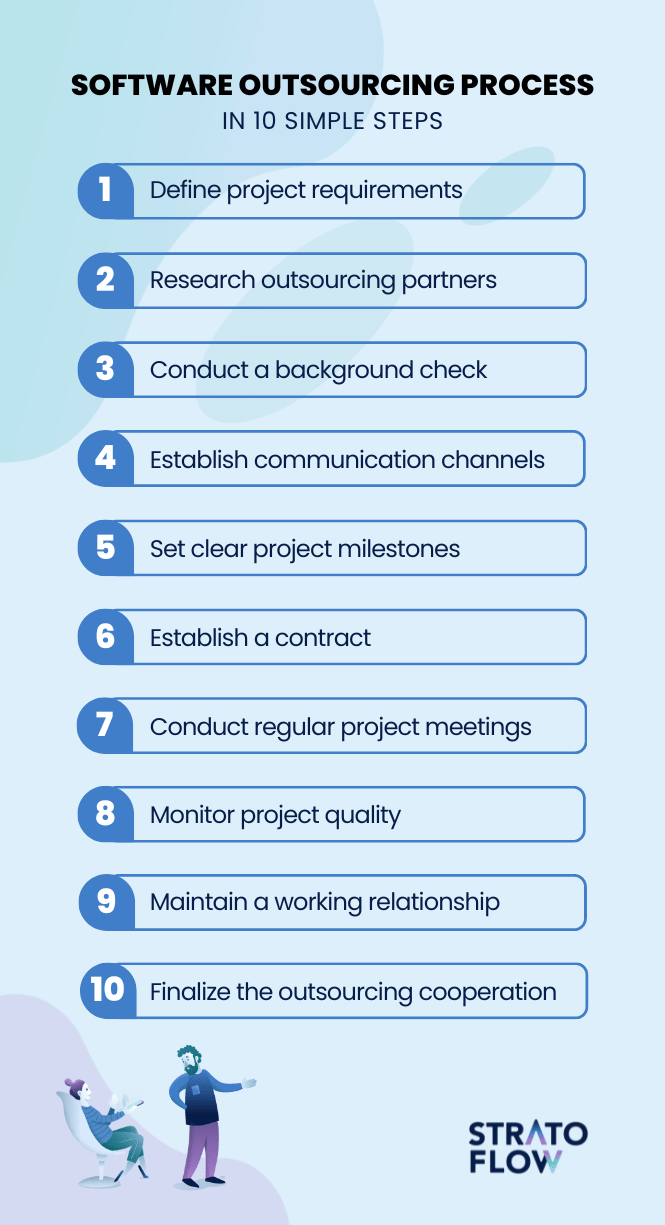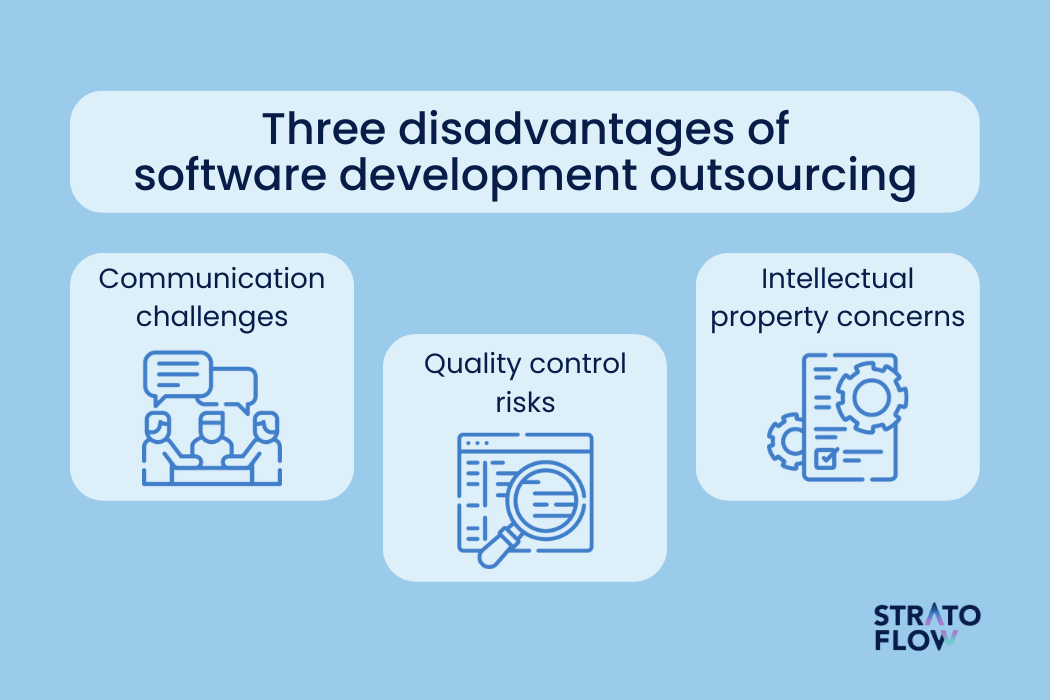
Complete Guide to Software Development Outsourcing for 2024
Are you tired of struggling to keep up with the ever-increasing demands and costs of software development projects?
Do you want to focus on your core business while still delivering high-quality software on time and within budget?
If so, software outsourcing may be the solution you’ve been looking for.
In this comprehensive guide to software outsourcing, we’ll walk you through everything you need to know to make outsourcing work for your business. From understanding the different software development models to choosing the right outsourcing partner, we’ve got you covered. So sit back, relax, and let’s dive into the world of software outsourcing!
Contents
What is software outsourcing?
Software outsourcing is a practice where companies delegate the development of their software to an external partner – a software house, leading software development company or software outsourcing company.
It is a business strategy where companies delegate some of their software development tasks to third-party vendors or offshore software development companies with the main objective of reducing costs, improving efficiency, and focusing on their core business activities.
The outsourcing software development company is responsible for completing the project, meeting the client’s requirements, delivering the software within the agreed timeline and budget, and sometimes providing post-release support.
The outsourcing company could be located in the same country as the client and in this situation, it will be inshoring the software development.
It could also be located in different countries or even in different parts of the world. In that case, it will fall in the category of either nearshoring or offshoring of software development services.
Software outsourcing can be used for various types of software development projects, including web application development, mobile application development, web development, software testing, maintenance, and general IT support.
In recent years, it has gained much popularity as an effective way to access specialized talent, leverage technology and expertise, and accelerate time-to-market while reducing operational costs.
However, it is important to remember that outsourcing software development still requires careful planning, effective communication, and a clear understanding of the risks and challenges to achieve the desired results.

Why is software outsource development important?
Software outsourcing services have become an essential part of daily of many businesses, providing access to knowledge, experience, talent and significant cost savings not otherwise attainable.
By outsourcing software development to a software development company, organizations can tap into a global talent pool of experienced programmers without being limited to their sometimes lackluster and expensive domestic market.
This allows them to develop high-quality software products faster and more efficiently than they would be able to do in-house.
In addition, outsourcing software development allows companies to focus on their core business activities rather than spending time and resources building and maintaining an insourcing development team.
[Read also: How to Find and Hire Full Stack Developers in 2024: Guide + Best Practices]

Why do companies outsource software development?
Focus on core business
As mentioned, by outsourcing software development, companies can focus on their core competencies and leave software development to experts.
Flexibility in scaling
Hiring a software development company allows companies to adjust their software development efforts to meet fluctuating demand, scaling up or down as needed.
Competitive advantage
Outsourcing software development has become essential for companies that want to stay ahead in the fast-paced business environment.
Solution for any size project
No matter the size, outsourcing software development can be an effective approach for various software needs.
Save time in recruiting
When companies outsource software development, they save significant time that would otherwise be spent on hiring individual developers.
Cost reduction
Outsourcing software development often results in lower development costs compared to in-house development.
Access to high-quality talent
Working with a software development company ensures access to quality developers, which improves the overall quality of the software project during the entire software development life cycle.

Software development outsourcing statistics
Just how important is software development outsourcing in today’s economy? let’s take a look at some key statistics:
- in 2024 over 76% of executives in the business and technology sectors say that their companies outsourced IT services.
- The global IT outsourcing market revenue has reached $460.10 billion in 2023.
- Freeing up resources to focus on core business is the most widely cited reason for outsourcing software development, cited by 49% of respondends.
- 50% of the total global outsourcing value is generated by software outsourcing firms,
- The trend towards outsourcing app development is expected to rise, with 34% of organizations adjusting their strategies to leverage software outsourcing opportunities. Conversely, only 9% are contemplating the development of software with an in-house team.
What are the types of software outsourcing?
In the first paragraph, we briefly mentioned that there are actually different types of software outsourcing in the software development industry based on the location of the software development company we want to work with.
Companies outsource software development to obtain software development services selecting one of three different strategies: offshoring, nearshoring, and onshoring.
Each strategy has its own unique advantages and disadvantages for software development companies that can significantly affect the success of a software project and its financial feasibility.
Let’s take a quick look at each of these types and see in which business scenario each works best.
[Read also: SDLC Guide: Coding and Development Phase in Software Engineering]

Offshoring
Offshoring software development is a strategy whereby an organization hires an external software outsourcing company located in another country (or even continent) to assist with its ongoing software development projects.
This practice has gained significant popularity in recent years due to its numerous benefits, such as access to specialized skills and the ability to greatly accelerate development cycles, but perhaps most importantly, the opportunity to achieve significant cost savings.
Offshoring has been made possible by rapid advances in communications and technology, which have made it easier to collaborate over long distances. With advanced tools that improve the efficiency of remote work, you can easily collaborate with a development team on the other side of the world.
By tapping into the expertise and resources of skilled developers in different countries, companies can access a global talent pool that can help them stay competitive in today’s fast-paced business environment.
It is important to note, however, that offshoring does present some challenges, such as cultural and communication barriers that can impact project progress. As a result, companies must carefully weigh the pros and cons of offshoring before deciding to adopt this strategy.

Onshoring
Onshoring, on the other hand, is the opposite of offshoring, as it is the strategy by which companies choose to conduct their software development projects within the borders of their home country, using local software developers.
Compared to the latter option, this approach can offer some valuable benefits, including better communication, cultural alignment, and easier quality control. By working with local developers, companies can avoid language barriers and cultural differences while supporting local jobs and economies.
Onshoring seems like the perfect choice, doesn’t it? Well, not so fast.
For starters, onshoring limits access to a relatively smaller talent pool compared to offshoring or global outsourcing. Perhaps more importantly from a business perspective, onshoring can also be more expensive than other outsourcing strategies due to higher labor costs and increased competition for skilled developers.
On the other hand, problems usually associated with offshoring are not as important today, such as the dreaded language barrier. If you take a look at the Polish software development market, you will quickly see that it is full of experienced software engineers and IT professionals with solid English skills due to ever-closer ties with Western countries.
Nearshoring
Nearshoring is a sort of middle ground between the two previous options. It is basically a software development practice where companies outsource their projects to teams in neighboring countries that share similar time zones and cultural backgrounds.
Nearshore software development allows companies to work with skilled developers in nearby countries, which can result in more efficient communication, easier travel arrangements, and better cultural alignment. In addition, nearshoring allows companies to expand their operations and enter new markets while maintaining close ties to their home base.
While nearshoring can be less expensive than onshoring, it can still be more expensive than offshoring to countries with lower labor costs. On the other hand, it may be easier to find common ground with an Eastern European custom software development company than, let’s say, with an Indian outsourcing partner.
[Read also: How to find software developers]

Software development outsourcing statistics
The software development outsourcing industry has demonstrated substantial growth and significance in the global market. As of 2020, the global IT outsourcing market was valued at approximately $92.5 billion, with a projected year-over-year growth rate of 3 to 5% between 2021 and 2024. By the end of 2023, software development outsourcing revenue alone is expected to soar to $122.7 billion, reflecting the industry’s robust expansion.
37% of small businesses rely on outsourcing their IT services, contributing to over half of the global outsourcing value.
In the United States, the business expenditure on outsourcing is projected to hit $731 billion by the end of 2023, further emphasizing the industry’s economic impact. Moreover, the trend extends beyond the United States to countries like the United Kingdom, Spain, and Australia, indicating a widespread reliance on outsourcing for software development and other IT services.
This growth is not only a testament to the industry’s strength but also to the critical role of technologies like cloud computing, which is considered an important tool by 90% of IT organizations.
What are the basic software outsourcing models?
Alright, we’ve already covered the main types of software development outsourcing based on the location of the outsourcing partner, but that’s not the end of the story.
Organizations may want to choose a different way of collaborating with software outsourcing companies based on their needs and preferences.

Staff augmentation
Let’s start with the IT staff augmentation model. It is a flexible outsourcing approach to software development services that allows companies to augment their existing teams with external resources. In this approach, instead of outsourcing the entire project, companies hire additional professionals on a temporary basis to work with their in-house team.
This model offers several benefits, including access to a broader pool of specialized talent, scalability to meet project needs, and cost savings compared to traditional hiring processes.
Staff augmentation enables organizations to quickly fill skill gaps, accelerate project timelines, and maintain control over the development process while leveraging the expertise and experience of external professionals.
It combines the strengths of in-house teams with the advantages of outsourcing, making it an attractive option for companies seeking flexibility and increased efficiency in their software development efforts if they already have some experience and knowledge in building digital products.
Project-based outsourcing
Project-based software development outsourcing is a popular approach in which companies delegate specific projects or tasks to external teams or vendors. Rather than maintaining a permanent outsourcing arrangement, companies choose this model to address specific development needs or tackle specialized projects.
As with the previous approach, project-based outsourcing provides flexibility and agility, allowing companies to adapt to changing business needs and access a broader range of technical skills.
Most importantly, this model provides a strategic advantage by allowing companies to focus on their core competencies while leveraging external expertise to execute specific software development projects efficiently and effectively.
While project-based outsourcing focuses on completing specific projects or tasks, staff augmentation is more about complementing and enhancing the capabilities of the currentteam and you need knowledge of existing infrastructure to do that. Project-based outsourcing provides a turnkey solution where the outsourcing partner takes responsibility for the entire project.
Dedicated teams
The third model of software outsourcing works by engaging an entire team of software developers to work on end-to-end software development processes for external clients.
It can be seen as a natural extension of the previous variations, with the caveat that in this approach the outsourced team of programmers takes full responsibility for the entire software development process, rather than just a part of it.
It’s, therefore, the most comprehensive approach, best suited to companies whose core business is not digital, but for which a working custom software solution is still essential to their operations, such as an online travel agency or company in the fintech industry.
Software outsourcing process in 10 steps
We already know what software development outsourcing is and what are its main types and variants.
Now it’s time to break this whole process down and list ten steps of software development outsourcing, from drawing initial plans to deploying the final product.

Step 1: Define project requirements
First and foremost, you need to establish clear and transparent project requirements.
Defining clear project requirements is a critical step in building new software solutions and outsourcing software development processes, as it lays the foundation for successful collaboration between the client and the outsourcing partner.
To effectively define project requirements, it is essential to follow a systematic approach. The fundamental question at the beginning of any planning phase is whether your idea is feasible or whether it will be an R&D job. It’s important because it completely changes the character of the whole project.
Once you are confident that your idea is achievable, you can proceed with thorough research and analysis to understand the target audience, market trends, and business goals. Engage stakeholders, including end users and internal teams, to gather diverse perspectives and insights. You need to be sure that there is a real need for what you have in mind.
Then clearly document functional and non-functional requirements, specifying desired features, user experience, performance benchmarks, and security measures.
Prioritize requirements based on their criticality and impact on project success. You can use visual aids such as wireframes and user stories to facilitate understanding and alignment.
By defining comprehensive and well-documented project requirements, organizations enable a common understanding between the organization and its prospective outsourcing partner
[Read also: How to prepare for outsourcing?]
Step 2: Research potential outsourcing partners
Once you have a plan for your future digital product, it’s time to research potential outsourcing partners. This is one of the most important steps, as choosing the right partner can significantly impact the success of your project.
To search for potential software development outsourcing partners you can use popular review aggregators such as Clutch. Using this platform you can filter the results by hourly rates, tech stack, project sizes, and location. Remember that the most valuable kind of promotion is word of mouth. You can reach out to your clients, partners, colleagues, and friends for recommendations.
Once you’ve compiled a list of software companies that have caught your attention, the first step in conducting effective research is to evaluate the outsourcing partner’s experience and expertise. Look for a track record of successful projects in your industry or with similar requirements. Review their portfolio and client testimonials to gauge their capabilities and client satisfaction, as well as their technical skills and the range of technologies they specialize in.
Consider the size and stability of the company and its scalability to meet your project needs. Trustworthiness is critical for large enterprise software projects, so look for certifications and industry affiliations that demonstrate their commitment to quality and best practices.
Finally, you can consider cultural fit and potential language barriers that may affect communication, as well as the partner’s location and time zone, as proximity can facilitate coordination and reduce potential roadblocks.
By investing time and effort in researching potential outsourcing partners, you can make an informed decision and select a partner that matches your requirements, expertise, and business objectives, setting the stage for a successful custom software development engagement.
[Read also: How to Hire Dedicated Developers – Your Ultimate Guide]
Step 3: Conduct a background check
After scoping, take the time to do a more thorough background check on potential outsourcing partners. Only by making sure you can trust your outsourcing partner can you create room for a successful relationship.
Start by checking the credentials and reputation of the outsourcing partner. Check their website and explore their professional networks to learn about their experience, client base, and industry recognition.
Then assess their financial stability and growth trajectory to ensure they have the resources to support your project. Legal considerations are critical, so review their structure, contracts, and compliance with intellectual property and privacy regulations.
A comprehensive background check should include reference checks. Reach out to their previous clients to get feedback on their performance, reliability, and timeliness.
By conducting a rigorous background check, you can gain confidence in your outsourcing partner’s capabilities, trustworthiness, and alignment with your project requirements, setting the stage for a successful and fruitful custom software development collaboration.

Step 4: Establish communication channels
Effective communication between a software development outsourcing partner and the client is critical to the success of outsourced development projects.
First and foremost, clear and transparent communication channels that facilitate real-time interactions should be established. This can include video conferencing, instant messaging platforms, email and project management tools. Regularly scheduled meetings and status updates can keep everyone informed and provide opportunities for clarification and feedback.
It is important to establish open and honest communication that encourages both parties to share concerns, challenges, and ideas.
Establish communication protocols and ensure that key stakeholders are involved at every stage of the project. In addition, document discussions, decisions, and action items to maintain clarity and accountability. Promptly address any communication gaps or conflicts that arise and encourage a solution-oriented approach.
Effective project management is extremely important in software development because there are hundreds of moving parts involved, so it is best to assign a dedicated project manager to serve as a single point of contact and ensure a seamless flow of communication.
Besides, how can we forget about project management principles? Take advantage of popular and widely used Agile methodologies such as Scrum, which can help break the project down into manageable sprints that encourage collaboration and flexibility.
By prioritizing effective communication and employing robust project management practices, software development outsourcing projects can overcome challenges, stay on track and achieve successful results.

Step 5: Set clear project milestones
How can you be sure your relationship with an outsourcing partner is running smoothly if you don’t have a benchmark against which to measure it? That’s where a project roadmap comes in. By setting clear project milestones, you can track project progress and monitor timely delivery.
To set effective milestones, start by defining the project scope and goals. Using agile tools and methodologies, break the project into logical phases or tasks and identify key deliverables for each stage. Consider the dependencies and priorities of these deliverables to create a logical sequence.
You can then assign specific schedules or deadlines to each milestone, taking into account the complexity of the tasks and the availability of resources. It is important to ensure that the milestones are realistic and achievable within the given timeframe. Collaboration with the outsourcing partner is essential during this process, as their input and expertise can help refine the milestone plan.
Regularly review and monitor progress against the milestones, keeping an open line of communication to address any challenges or deviations. Some adjustments are almost inevitable as the project progresses, so flexibility is an important factor.
Step 6: Establish a contract
Once all the details are ironed out, it’s time to make your partnership official.
To create an outsourcing contract that is free of mistakes and deviations, you must first clearly define the scope of work, including specific tasks, deliverables, and project timelines.
Leave no tasks and deliverables open to further interpretation. Specify project requirements, technologies to be used, and any performance benchmarks or quality standards. The more specific you are at this stage, the less stress, problems and disputes there will be later.
Since intellectual property rights are critical in this type of project, clearly outline ownership and confidentiality provisions to protect sensitive information and ensure proper transfer of intellectual property. Establish clear payment terms, including milestones or payment schedules, as well as any penalties or incentives tied to project completion.
Finally, address dispute resolution mechanisms and jurisdiction in the event of a dispute. Even if you do not want to use this clause in the future, consider termination clauses, including provisions for early termination, transition assistance and post-contract obligations.
Of course, it is highly advisable to seek legal advice when drafting the contract to ensure compliance with applicable laws and to protect the interests of both parties.

Step 7: Conduct regular project status meetings
Now that the real coding is underway, make sure your project is always on the right track.
The agile methodology we’ve discussed in the previous steps emphasizes iterative development in short sprints, allowing for flexibility and adaptability throughout the project.
After each development sprint, conduct regular meetings, such as daily stand-ups or sprint reviews, as they provide invaluable opportunities for both parties to discuss project updates, address challenges, and make necessary adjustments. These meetings promote transparency, open communication, and rapid decision-making.
By breaking the project into smaller increments, Agile enables faster feedback cycles and early identification of problems or needed changes.
This iterative approach enables continuous improvement and minimizes the risk of misalignment between customer expectations and the development process.
Regular project status meetings, combined with agile development, foster collaboration, maintain project momentum, and ensure that the software development project stays on track to deliver high-quality results within the desired timeframe.
Step 8: Monitor project quality
Monitoring project quality throughout the software development process, especially in the context of outsourcing, is paramount to ensuring the delivery of a robust and reliable software solution.
Outsourcing software development introduces additional layers of complexity, such as geographic and cultural differences, that can potentially impact quality.
By actively monitoring project quality, both the customer and the outsourcing partner can mitigate risk and maintain high standards.
Regular code reviews, automated testing, and quality assurance processes help identify and resolve issues early and ensure compliance with best coding practices and industry standards. Establish clear quality metrics and performance indicators to objectively evaluate software functionality, performance, security, and usability.
By prioritizing project quality monitoring, organizations can reduce risk, minimize reworks, and ensure the development of a high-quality software product that meets or exceeds expectations, ultimately leading to customer satisfaction and long-term success.
[Read also: The Most Common Problems in Software Development]
Step 9: Maintain a good working relationship
Any collaborative effort, if properly taken care of, can yield great outcomes.
That’s why maintaining a good working relationship during a project is crucial when outsourcing software development services, as it fosters cooperation, trust, and successful project outcomes in the present and the future.
To maintain a positive working relationship, effective communication is key. Ensure that both the client and the outsourcing partner have a clear understanding of project goals, expectations, and timelines.
Regularly scheduled meetings, both virtual and in-person when possible, allow for real-time discussion, issue resolution and progress updates.
Foster a collaborative environment that encourages teamwork, knowledge sharing, and openness. Encourage proactive and constructive feedback to foster a culture of continuous improvement. It is critical to be responsive and prompt in addressing questions, concerns, and feedback from both sides.
Finally, don’t forget to celebrate milestones and accomplishments, and recognize and motivate each other’s efforts.
A good working relationship leads to increased productivity, efficiency, and innovation, but it can also be very beneficial for future software development projects.
Step 10: Finalize the cooperation and deploy the software
Finally, we come to the final deployment and closure of the entire collaboration.
First, conduct a comprehensive project review to ensure that all objectives and deliverables have been met.
A good practice is to conduct a lessons-learned session to identify areas for improvement and gain valuable insights for future projects. Evaluate overall performance and consider providing feedback and references to the outsourcing partner.
Case studies and customer testimonials are extremely valuable to custom software development companies, so remember to provide these as they will solidify the prospects for additional future collaboration. It is important to discuss any remaining obligations, such as post-project support or maintenance, and ensure a clear understanding of roles and responsibilities.

Pros and cons of outsourcing software development
Working with a custom software development company has become an increasingly popular way to conduct development projects without advanced technical knowledge.
And there’s a reason for that.
Outsourcing software development offers companies many unique and immensely powerful advantages. Here are five key examples:

Pros of software development outsourcing
Cost savings
Software development outsourcing can be a game changer for companies looking to optimize their budgets and achieve cost savings.
By leveraging the expertise and resources of external software development teams, companies can significantly reduce costs compared to traditional in-house development.
By outsourcing to countries with lower labor costs, companies can access highly skilled professionals at a fraction of the cost of hiring and maintaining an in-house team. They can also avoid expenses such as salaries, benefits, training, and infrastructure setup, which are not only a financial burden but also a significant logistical headache.
By taking competitive advantage of software development outsourcing, companies can focus their financial resources on other strategic initiatives while still achieving high-quality software solutions within their budget constraints.
Access to specialized skills
Software development outsourcing opens up a world of opportunities for companies to access a wider talent pool of experienced software developers and IT professionals.
By partnering with outsourcing companies, organizations can tap into a global network of skilled individuals with diverse technical backgrounds and industry expertise. This allows companies to overcome the limitations of geographic boundaries and local talent availability.
Outsourcing provides access to talent with specialized skills, cutting-edge knowledge and a wealth of experience across multiple technologies and domains.
Faster time-to-market
In today’s digital marketplace, time to market has become a critical factor in business success. With constantly evolving consumer demands and fierce competition, the ability to bring products and services to market quickly can make all the difference. Speed is of the essence as companies strive to capitalize on emerging trends and customer needs before their competitors.
By partnering with external software development teams or outsourcing firms, companies can leverage their expertise and resources to accelerate the product development lifecycle.
These programming experts bring efficiency and agility to the development process, accelerating project timelines and reducing time-consuming tasks.
In some cases, outsourcing allows for around-the-clock development when you choose development teams located in different time zones, allowing for continuous progress even when the internal team is not actively working.
By leveraging the outsourcing partner’s dedicated resources and streamlined processes, companies can optimize their development cycles, complete projects faster, and achieve faster time-to-market for their digital products.
[Read also: How to speed up the software development process]
Scalability and flexibility
Outsourcing allows companies to seamlessly scale their development capabilities up or down based on project needs and market conditions.
Whether there is a need to ramp up development resources for a large project or scale down during quieter periods, outsourcing software development company provides the flexibility to adapt quickly without the long-term commitment of hiring and managing an in-house team.
External development teams are prepared to handle diverse workloads and can be easily aligned with specific project goals and timelines.
This scalability and flexibility offered by software development outsourcing enable companies to optimize resource allocation, increase operational efficiency and respond quickly to market demands.
By leveraging external skills and staff augmentation, companies can focus on their core competencies, drive innovation and achieve sustainable growth in an ever-changing business landscape.
Focus on core competencies
By entrusting software development tasks to external experts, companies can relieve themselves of the burden of managing complex development processes, freeing up valuable time and resources.
Outsourcing eliminates the need for companies to divert attention away from their core strengths and invest in building and maintaining in-house development teams. Instead, they can focus their efforts on strategic planning, innovation, and maintaining customer relationships.
Outsourcing partners take responsibility for the technical aspects of software development, ensuring that projects are executed efficiently and to specifications. As a result, organizations can streamline operations, increase productivity and improve overall business performance.
Cons of software development outsourcing
Of course, there’s always the other side of the coin, and while software outsourcing offers some very tempting benefits, there are also some disadvantages that need to be mentioned.

Communication challenges
Software development projects often involve diverse teams working together, which can lead to communication challenges. Effective communication is critical to project success, as miscommunication can lead to delays, misunderstandings, and even project failure. Common communication issues in software development include language barriers, time zone differences, and cultural nuances.
However, there are strategies for overcoming these challenges.
First, as mentioned in the previous section, establishing clear communication channels and using collaboration tools can help streamline communication among team members. Regular video conferencing and virtual meetings can bridge the gap created by distance and time zones.
Second, maintaining open and transparent communication channels encourages team members to voice concerns, share progress, and seek clarification when needed.
Finally, providing detailed project documentation, establishing communication protocols, and assigning a dedicated communication coordinator can facilitate a smoother flow of information.
Quality control risks
Working in a remote environment with distributed teams of developers can sometimes lead to miscommunication and negligence. This is especially true when a company with virtually no technical expertise chooses a software outsourcing company with a questionable track record when it comes to code quality.
There are two main ways to circumvent this problem: proper due diligence and thorough quality control.
Before you sign any contracts, make sure that the partner you choose really does spend the time and effort to build its software according to the latest quality standards. In addition, remember that adopting industry-standard coding practices, conducting code reviews, and using automated testing tools can greatly enhance the quality control process.
By prioritizing quality control and implementing effective risk management practices, software development teams can deliver reliable, secure, and high-performing software solutions that meet or exceed customer expectations.
Intellectual property concerns
Outsourcing software development can raise intellectual property (IP) concerns due to the sharing of proprietary information and code with external parties.
There are several steps that can be taken to address IP concerns when outsourcing software development. First, as mentioned above, conduct thorough due diligence, this time on IP protection practices.
Second, non-disclosure agreements (NDAs) should be signed to establish confidentiality obligations and clearly define the scope of information shared. It is also advisable to include specific clauses in the contract that address intellectual property rights and ownership. In addition, companies can implement technical safeguards such as restricted access to sensitive information, version control systems, and encryption to ensure the security of intellectual property during the development process.
How to estimate the cost of software outsourcing?
By now you should have a pretty good idea of what software development outsourcing really is and what advantages it brings to the table.
Let’s try to answer the key question we haven’t touched on yet – how much does a software development cost?
Every software project is different, so it’s natural that each end of it has to be considered separately. That said, let’s try to make some rough estimates.
How much does an average software development project cost?
Simple Proof of Concept Applications
Time frame – 4-8 weeks
Estimated cost – $25k-$35k
[Learn more about Proof of concept (POC)]
Medium-sized Commercial web applications
Time Frame – 4 Months
Cost – $60k-$100k
Large Enterprise applications
Time Frame – 8 Months or more
Cost – $150k and more
Key rules of software project estimation
In one of our previous articles, we took a closer look at how to estimate a software development project, so we won’t go into all the details here.
However, let’s summarize the four key rules of project estimation from that article to get a general understanding of what to look for when trying to get a rough understanding of project costs.
Feasibility comes first, estimation second
In the first step of our ten-step guide to the software outsourcing process, we pointed out the importance of proper planning and defining initial requirements, but perhaps, more importantly, determining the feasibility of the project itself.
What do we mean by that?
In today’s digital market, almost everything has already been created by someone else. All that’s left is to improve on someone else’s idea or approach. But every now and then there’s an idea for a product that’s almost revolutionary and has no counterpart in the market. What then?
In this situation, you have to make sure that the project is feasible, or you have to venture into the realm of R&D projects. The latter have their own set of rules and are inherently difficult to assess, simply because their success is not readily apparent.
But if you are dealing with something simpler that experienced developers know how to tackle, then you can move on to more precise estimation.

Extrapolation should be your foundation
One effective approach to estimating software development projects is to use the power of extrapolation. Select a few tasks that are indicative of the complexity of the project, estimate the time and effort required to complete them, and then multiply these estimates by the total number of tasks to be completed. This method may not be perfect, but it is good enough for initial estimates.
Know exactly what you want to accomplish
Once again, we would like to put special emphasis on the analysis phase of software development projects.
Before you start spending money on outsourced teams of programming professionals, you need to know what you want to achieve. You don’t want your final product to be too “hard coded” if scalability is a priority, just as you don’t want to spend extra budget for great flexibility if it’s just not necessary.
Remember about hidden costs
As with any engineering problem, software development projects rarely go exactly according to plan.
Whether it is an urgent need for additional functionality or a major redesign of the system’s user interface, some things in such projects simply cannot be planned for in advance. The best thing you can do is to leave some leeway and budget for unexpected changes and other hidden costs.
How to limit the costs of software development outsourcing?
Planning, prototypes, teams of experienced software engineers-what do they all have in common?
They require a lot of resources, but most of all time and money.
Is there a way to make outsourcing software development more cost-effective? Here are three strategies to consider if you’re outsourcing on a budget:
Consider low-code approach
In recent years, low-code development platforms (LCDP) and no-code development platforms (NCDP) have emerged as disruptive innovations in the IT industry.
These platforms provide pre-built elements and easy-to-use interfaces that enable developers to quickly create software applications without having to code everything from scratch. This technology significantly accelerates the development process and minimizes the time and energy required to build complex software applications.
One notable example of a low-code platform based on the open-source license, Openkoda, which aims to cut development costs by up to 30% all while maintaining complete data ownership. In addition, developers can use custom, lightweight Java code to build complex business logic without wasting time on mundane and repetitive tasks.
Carefully compare offshore and nearshore options
If cost savings are a top priority for you when outsourcing software development, you should really pay close attention to which country you want to outsource your programming efforts. Some countries, even if they are relatively close together on the map, can have very different rates for software engineers. Take Eastern Europe as an example.
According to the latest report by the Sedlak & Sedlak consultancy, developers specializing in Java programming language with multiple years of experience can earn around 3700 euros per month in Poland – one of the most lucrative IT outsourcing locations in Europe. This is over 40% less than in Germany which is Poland’s direct geographical neighbour.
Build long-term partnerships
Building long-term partnerships can be a key factor in achieving significant cost savings and maximizing the value of outsourcing.
These partnerships go beyond project-based engagements and foster a deep understanding between companies and their outsourcing providers. With long-term partnerships, companies can realize a number of benefits that directly impact their bottom line. First, they gain access to better pricing agreements, taking advantage of negotiated rates and volume-based discounts.
Second, repetitive onboarding and transition costs are reduced as the outsourcing partner becomes intimately familiar with the company’s needs and processes. This streamlines operations, minimizes inefficiencies and saves money in the long run.
By fostering long-term partnerships, companies can achieve sustainable cost efficiencies while realizing the full potential of outsourcing.
Facts and statistics about software outsource development in Poland
Poland’s economic structure is a sophisticated mix of industrialization and market strategies, which positions it as a significant economic player in the European Union. It is recognized as the sixth largest economy by nominal GDP and the sixth largest by GDP in the EU in 2023. Poland leads as the fastest growing economy in Central and Eastern Europe, showcasing its robust software development sector.
The 2008 financial crisis had a lesser impact on Poland compared to other Western economies. As a result, the country continued to make technological and economic progress, gradually establishing itself as a major hub for companies outsourcing software development.
Foreign investment in Poland, particularly in the IT sector, is highly profitable. Research by KPMG and the American Chamber of Commerce shows that American investments in Poland are 50% more valuable than in other countries, making it a lucrative market for outsourcing software development.
Poland’s IT Industry: A hub for software development companies
In the IT sector, Poland’s market for software development companies is a major contributor to the national economy, ranking 33rd among all industries. It accounts for approximately 8% of the country’s GDP, underscoring its economic importance.
The total value of the Polish IT market has been growing steadily and will reach a significant PLN 53 billion by 2021. This growth trajectory underscores the crucial role of software development and outsourcing software development in Poland’s economic landscape.

Why choose Stratoflow to build an offshore development team?
When outsourcing software development and looking for specialists with the extensive knowledge of Java programming language you cannot have found a better partner than Stratoflow.
We a custom software development company that firmly believes that software craftsmanship, collaboration and effective communication is key in delivering complex software projects. That is why we provide our clients with the support of highly specialized, dedicated teams. We specialize in building enterprise software projects and integration systems for clients located in Western Europe and the US. Our main office is located in the beautiful city of Wroclaw which is considered to be one of the main tech hubs in Poland. This allows us to create high-performance Java applications and programs capable of processing vast amounts of data in a short time. As a result, the solutions designed for our customers contribute to their business development. We specialize in travel software, ecommerce software, and fintech software development. In addition, we are taking low-code to a new level with our Open-Source Low-Code Platform.
If you have a development project that you would like to discuss, don’t hesitate to contact us.
Outsourcing software development – conclusion
In the fast-paced world of technology, software outsourcing has become a strategic choice for companies looking to realize their full potential.
By harnessing the power of global talent, outsourcing opens doors to innovation, cost savings, and accelerated time-to-market. From understanding different outsourcing models to overcoming communication challenges and ensuring quality control, this comprehensive guide provides a roadmap for successful software outsourcing ventures.
So dare to innovate, dare to outsource, and let your digital dreams take flight.
